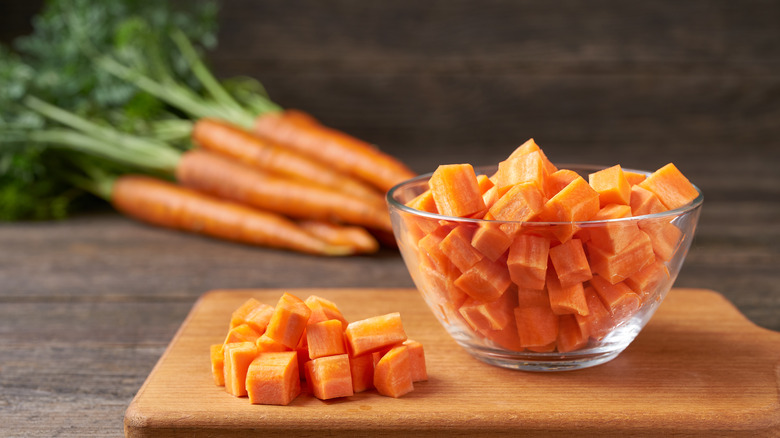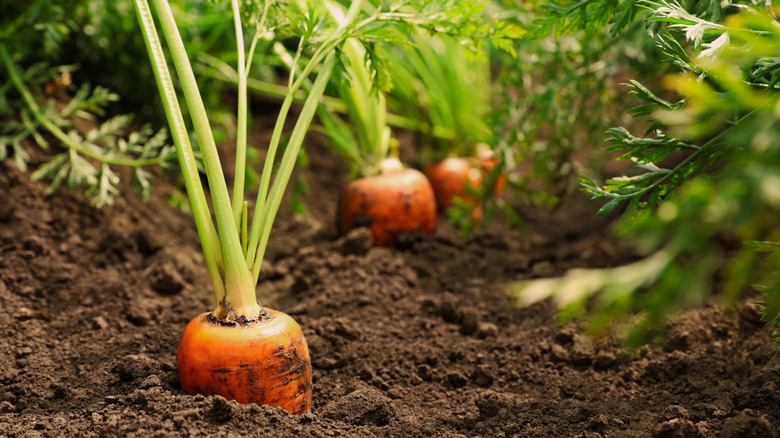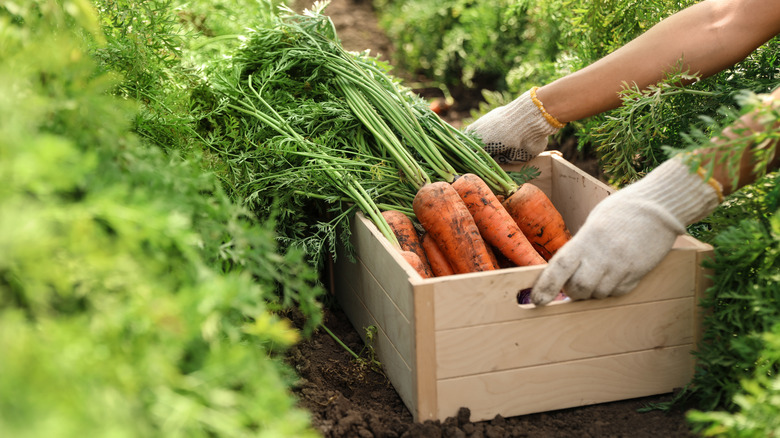Most Of The World's Carrots Come From This Country
Growing up, you may have been told to eat more carrots because they will improve your eyesight as mom piled more glazed carrot coins on your plate. Turns out mom wasn't too far off. Carrots contain many nutrients that are beneficial for eyesight, as well as can help to lower cholesterol levels, according to Healthline.
The orange vegetable is versatile and commonly shows up as spears on raw vegetable dip trays, as well as cooked with potatoes and roast beef for a hearty dinner. They are also used around the world in different dishes, from a topping on a Vietnamese banh mi sandwich to being incorporated into France's famous boeuf bourguignon. Annually, an American will eat around eight pounds of carrots, according to data from Statista. In fact, Americans ate about 8.6 pounds of fresh carrots in 2021, compared to 8.3 pounds in 2020, 8.5 pounds in 2019, and a high of 12.2 pounds in 2018. That's in addition to about 1.4 pounds of frozen carrots annually, reports Illinois Extension.
Many good reasons to eat carrots
Carrots are full of vitamins and minerals, making them a great addition to a person's diet. According to Healthline, carrots contain beta carotene, which the human body converts into vitamin A, an important nutrient for eye health, growth, development, and the immune system. Biotin and vitamin B6 are also found in carrots, along with vitamin K1, which contributes to healthy bones. In addition, the potassium in carrots aids blood pressure control. With that being said, consider keeping the peel on carrots because it contains about half of the vegetable's antioxidants, per Good Housekeeping. Therefore, simply, wash the carrot thoroughly instead of peeling off the outer layer.
More common at farmers' markets than at grocery stores in the United States, there are carrots that are available in colors other than orange, including purple, red, and black. Luckily, all colors are nutritious, but the number of nutrients varies by color. Black and purple carrots are believed to have antioxidant, anti-inflammatory, and anti-microbial properties. Despite the health benefits, it is possible to eat too much of a good thing. According to the Cleveland Clinic, skin discoloration is possible from consuming too much beta-carotene, which is found in carrots. However, you'd need to eat about 10 carrots per day for a few weeks for your skin to take on an orange hue, called carotenemia. Keep in mind though, it's not high-risk.
They've been around for a while
The orange veggie has been used by humans for quite some time now, according to Britannica. However, they were likely first used medicinally. Wild carrots were first found in Eurasia and began to be cultivated by the 13th century in China and northwestern Europe. The seeds for wild carrots, however, arrived in North America with European settlers. From then, carrots grew in popularity during the 20th century as their nutritional benefits were learned. Another factor leading to vegetables' popularity was that they could be eaten months after being harvested and stored properly, per Vegetable Facts.
However, it took some time before carrots became common as edible vegetables in the United States. It wasn't until after soldiers returned home from World War I with knowledge of how carrots were used in European cuisine and how they nourished the soldiers during the war that they began to be consumed in the U.S. In fact, the vegetable became even more popular during World War II when the English government encouraged its citizens to grow carrots at home.
Top cultivator of carrots
Perhaps not surprisingly, but one of the first countries to use carrots also continues to grow the majority of them. According to the Food and Agriculture Organization of the United Nations (FAO), mainland China cultivated more than 18 million tonnes of carrots and turnips in 2020. The second largest grower was Uzbekistan with over 2 million tonnes, followed by the United States with more than 1 million tonnes. And rounding out the top five are the Russian Federation with almost 1.4 million tonnes and Ukraine with 862,460 tonnes.
Most of the carrots that China grows during the winter, which are approximately 90%, are exported to other countries, per World Atlas. The largest importers of Chinese-grown carrots are Saudi Arabia, Canada, Thailand, and Malaysia. By being able to grow carrots in different regions of the country, China is able to harvest the vegetable year-round. In the United States, the top states for carrot crops are California, Texas, and Michigan.
Whether you plan to eat maple-roasted carrot salad or roasted carrot and parsnip soup, you can't go wrong when you're incorporating carrots.



